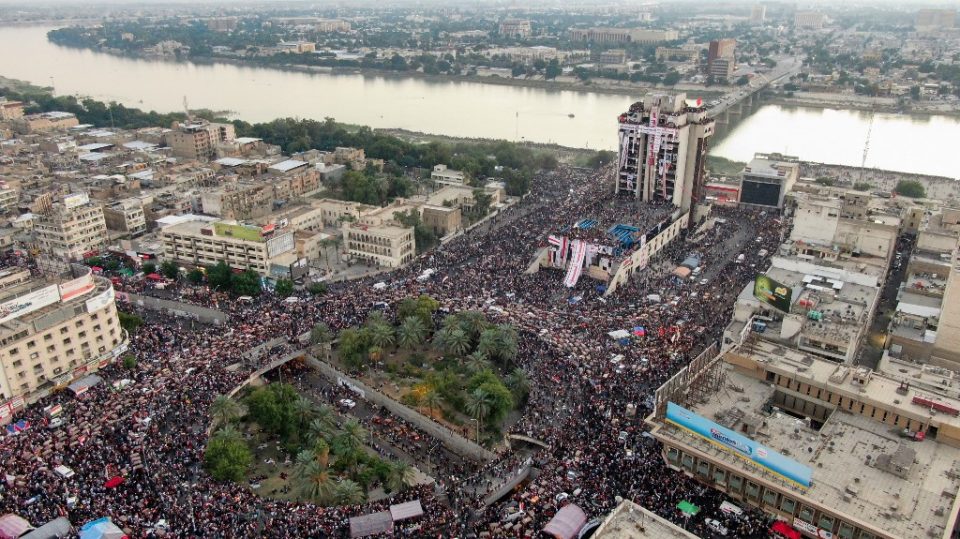
BAGHDAD, Iraq (AFP) — Protesters in Iraq’s capital and the country’s south shut down streets and government offices in a new wave of civil disobedience Sunday, escalating their month-long movement demanding a wholesale change of the political system.
Demonstrations broke out on October 1 in outrage over rampant corruption and unemployment in Iraq. They were met with a violent crackdown that left dozens dead.
Since resuming late last month, the protests have swelled again with the support of students and trade unions, who jointly announced a campaign of non-violent resistance on Sunday.
In Baghdad, university-age demonstrators parked cars along main thoroughfares to block traffic on the first day of the working week in the Muslim-majority country, as police officers looked on.
Other students took part in sit-ins at their schools, and the national teachers union extended a strike they began last week. The engineering, doctors, and lawyers syndicates have all backed the protests.
“We decided to cut the roads as a message to the government that we will keep protesting until the corrupt people and thieves are kicked out and the regime falls,” said Tahseen Nasser, a 25-year-old protester in the eastern city of Kut.
In the southern city of Diwaniyah, a banner hanging on the headquarters of the provincial council proclaimed: “Closed by order of the people”.
– ‘Government lies’ –
The government has proposed a string of reforms, including a hiring drive, social welfare plans and early elections once a new voting law is passed.
But protesters have stayed on the streets, condemning the political class wholesale.
“We decided on this campaign of civil disobedience because we have had it up to here with the government’s lies and promises of so-called reform,” said Mohammad al-Assadi, a government employee on strike in the southern city of Nasiriyah.
Demonstrators there organised sit-ins on bridges leading out of the city, as well as its main streets and squares.
Schools and government offices were closed in Baghdad and half a dozen other cities in the south.
In the oil-rich port city Basra, public schools were shut for the first time since the movement erupted in October.
Protesters also kept closed the highway to the Qasr port, one of the main conduits for food, medicine and other imports into Iraq.
A source at the port told AFP that around a dozen ships had pulled away to take their goods elsewhere on Saturday, after waiting to unload their cargo.
The spreading sit-ins indicate a new phase in the protests, already hailed as the largest grassroots movement in Iraq in decades.
Civil society ‘recovers’
Under ex-dictator Saddam Hussein, rallies that were not exuberantly supporting him or his Baathist government were banned.
After he was toppled by the US-led invasion of 2003, political parties tussling for influence were the only actors able to draw large numbers out into the streets.
“Iraq’s civil society which was undermined by decades of Baathist authoritarianism and sectarianism is recovering,” wrote Harith Hasan, a scholar at the Carnegie Endowment’s Middle East Center.
But the movement has also been bloodied by the deaths of more than 250 people, the vast majority of them protesters.
On Saturday, medical sources told AFP at least one person was killed and dozens wounded in clashes with security forces near the capital’s Tahrir Square, a focal point for demonstrators.
Young protesters have spilt over from Tahrir onto two main bridges leading to the western bank of the Tigris.
They parked cars across roads on Sunday, while large numbers of students and schoolchildren thronged towards the square, AFP journalists said.
Alaa Wissam, a 25-year-old architect, said young people were heading to the square to volunteer their help.
“This thing will help young people to have a role in the change that is happening,” she said.
Riot police deployed along the bridges have fired tear gas to keep back protesters, who have dug in to their positions behind their own barricades.
Amnesty International slammed Iraqi forces days ago for using two types of military-grade tear gas canisters that have pierced protesters’ skulls and lungs.
Rights groups have also expressed worry over the detention of protesters, journalists and medics.
On Sunday, the Iraqi Human Rights Commission said Saba Mahdawi, a doctor and activist, had been abducted the previous evening after providing medical aid to protesters.
Mahdawi’s mother said she had been abducted by “armed, masked men on pick-up trucks” as she headed home from Tahrir late on Saturday evening.
The Commission did not say who may have seized her but urged security forces to investigate the matter and other “organized kidnapping operations” in recent weeks.
It called Mahdawi’s abduction “a mark of shame for the whole of Iraqi society”.
Later, the interior ministry announced the release of a second demonstrator, seized two days earlier, without providing a name.
© Agence France-Presse







